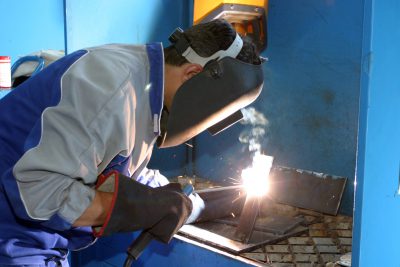
If you need assistance with welding fume testing/sampling as discussed in this article, call us at 973-366-4660 or email us at info@atlenv.com for details and a free estimate.
Written By: Robert E. Sheriff, CIH, CSP, President
October 23, 2019; Updated October 2021
Welding Fumes, Hazard to Welder’s Health
Welding fumes contain a variety of metals, gases, and chemicals that can wreak havoc on a welder’s lungs. For example, the smoke emitted from welding on stainless steel may contain hexavalent chromium which is very dangerous to welder’s heath. The smoke may also contain lead, manganese, cadmium, nickel, zinc and any other metals that are components of the welded metal and the welding rod/wire/stick. All welding emits fumes whether it’s MIG, TIG, stick, torch, laser, and/or plasma torch welding. The hazards of each are different, and the only way to determine if the welding process can be a hazard to a welder’s health is to sample the welder. The most common way is to place a portable sampler on the welder that collects a “breathing zone” sample of the welding emissions, and have the sample analyzed by a properly accredited laboratory that does industrial hygiene sample analysis.
Welding is tough work. Not many who begin as welders retire as welders. Many end up with respiratory problems such as COPD and practically every welder eventually develops cataracts. Neck and back problems are also a foregone conclusion.
Types of Welding and Health Hazards
There is also a long list of possible health problems depending on the type of welding. One welding fume hazard, hexavalent chromium, has been identified by OSHA as a suspect carcinogen. OSHA now enforces and regulates its exposure limits (29 CFR 1910.1026-General Industry) and (29 CFR 1926.1126-Construction). The most likely exposure to “Chrome VI” is welding of stainless steel or chrome, but can also occur when using chromium-containing welding rods when doing stick welding.
Other Welding Health Hazards Include:
Manganese: Comes from welding on carbon steel or heavy production welding of other steel, it can cause nerve system damage resulting in Parkinson’s disease. See Table Z-1 of OSHA Standard 29 CFR 1910.1000.
Nickel: From nickel alloy electrodes, nickel plating, and cryogenic steels, it’s a suspect cancer-causing agent. See Table Z-1 of OSHA Standard 29 CFR 1910.1000.
Lead: Present in most steels and in higher levels in maraging steel and from lead paint on existing metal surfaces, it can damage muscles, bone, and nerves; especially dangerous to welders’ families with children 6 years or under. See OSHA Standard 29CFR1910.1025 – OSHA LEAD STANDARD.
Copper Welding: Wires (MIG), Bronze, Copper Coating, and Copper Brazing, Brass; it can cause lung irritation. See Table Z-1 of OSHA Standard 29CFR1910.1000.
Zinc: Plated metal, galvanized metals, can cause Metal Fume Fever which causes a flu-like illness. See Table Z-1 of OSHA Standard 29CFR1910.1000.
Total Welding Fume: From heavy production welding and welding inside a vessel, pipe, or container without good air circulation; can cause chronic respiratory problems (COPD and Chronic Bronchitis). This is the type of welding that creates the greatest possibility of adverse health effects for a welder regardless of the type of welding performed.
Ozone: MIG and TIG welding and aluminum welding can cause eye, nose, and throat irritation and lung damage. See Table Z-1 of OSHA Standard 29CFR1910.1000.
And that’s not all. Workers welding or cutting surfaces with paints, solvents, plastics, and other coatings will likely be exposed to decomposition products such as oxides of nitrogen, phosgene, carbon monoxide, and carbon dioxide.
Evaluation
Evaluating each working environment is essential. Under OSHA rules, it is generally required to first identify hazards that are present and then to implement controls, such as ventilation or substitution of high hazard materials for less hazardous ones. Implementing controls can also include the addition of personal protective devices and/or more effective training.
Respiratory Protection
It is important to remember that respiratory protection is the least effective method of protecting the worker from welding fume hazards. In some cases, such respirators may increase the potential for injury because of the added burden the respirator adds to all the other necessary protective equipment that the welders must wear.
Testing/Sampling
Testing for welding fume hazards such as monitoring or personnel sampling/testing can be performed by a Certified Industrial Hygienist or an Industrial Hygienist.
A Certified Industrial Hygienist, by virtue of training, education, and experience, has demonstrated the ability to recognize and test for welding fume hazards and is able to recommend appropriate controls.
Our primary service areas are: NJ, NY, NYC, PA, CT, DE, (Boston) MA, RI, Wash DC, WI, MD, MI, (Chicago) IL, VA, IN, (Atlanta) GA, AL, NC, SC, TN, (Dallas, Ft Worth) TX, OK, DC, AR. We can service most other areas of the U.S. but additional travel charges will be applied.



